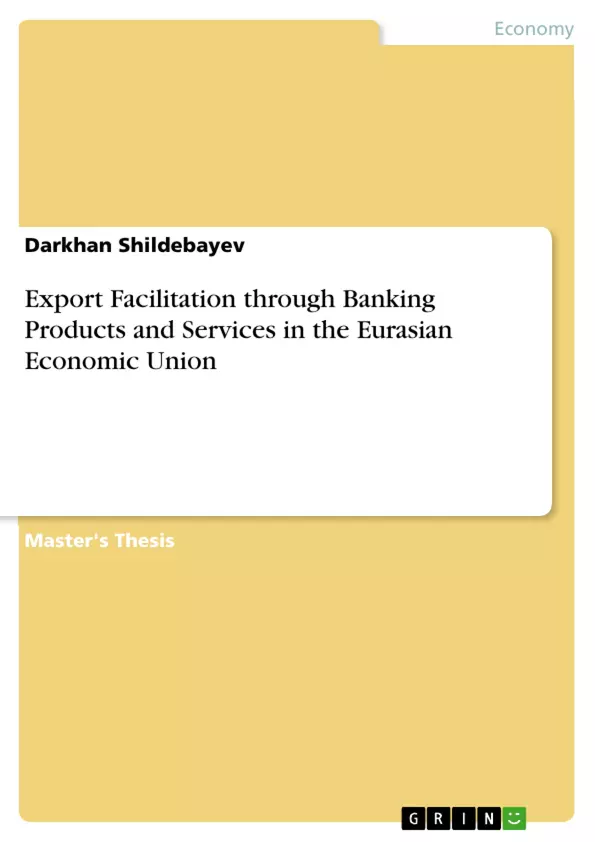Small and medium enterprises contribute to more than 50% of GDP in the developed economies. Yet, in developing markets, such as Kazakhstan, this sector remains untapped since SMEs are considered risky and not transparent enough to be financed by banks.
Meanwhile, there is a lot of discussion whether SMEs in Kazakhstan can withstand the rivalry from their competitors within the newly formed Eurasian Economic Union. Remaining a threat for weak SMEs, the economic union is also a great opportunity for exporting SMEs in Kazakhstan to expand their businesses through exporting their products and services to the member states of the union.
The study aims at identifying the challenges that are faced by the exporting SMEs in Kazakhstan when applying for banking products. Out of these challenges, a number of recommendations are developed for the banking industry in Kazakhstan.
The results of the quantitative analysis applied in the study reveal that high interest rates and bank fees, documentary requirements and communication issues are the main challenges that are faced by the exporting SMEs in Kazakhstan. Therefore, banks are recommended to improve their risk assessment methodologies, to provide the SMEs with training programs and to improve their communication with the exporting SMEs.
The findings of the study and the proposed recommendations can be applied both by the private and state banking institutions. Moreover, banks and other financial institutions can develop their own measures based on the findings revealed in this study. The measures can then be implemented in order to make the banking products more accessible for the exporting SMEs in Kazakhstan.
Inhaltsverzeichnis (Table of Contents)
- Introduction
- Background
- Research question, objectives and purpose
- Structure of the thesis
- Current Economic Developments
- The role of Exports in the Economy of Kazakhstan
- Characteristics of SMEs and Their Role in an Economy
- Literature Review
- The role of Banking Industry in Facilitating Exports
- Conceptualized Model
- Methodology
- Research Method
- Questionnaire Design
- Results
- Summary of the findings
- Generalizability of the results
- Discussion
- Answer to the research question
- Conclusion
- Practical implications and contribution to the existing knowledge
- Limitations
- Recommendations for future research
Zielsetzung und Themenschwerpunkte (Objectives and Key Themes)
The master thesis aims to identify the challenges that are faced by exporting SMEs in Kazakhstan when applying for banking products and to develop recommendations for the banking industry in Kazakhstan to overcome these challenges.
- The role of SMEs in Kazakhstan's economy and the impact of the Eurasian Economic Union on them.
- The challenges faced by exporting SMEs in Kazakhstan when accessing banking products and services.
- The specific needs of exporting SMEs in Kazakhstan in terms of banking products and services.
- Recommendations for the banking industry in Kazakhstan to improve their support for exporting SMEs.
- The potential impact of improved banking services on the competitiveness of exporting SMEs in Kazakhstan.
Zusammenfassung der Kapitel (Chapter Summaries)
- Introduction: This chapter provides an overview of the research topic, the research question, the objectives of the study, and the structure of the thesis. It also sets the context by outlining the current economic development in Kazakhstan and the importance of exports for the country's economy.
- Current Economic Developments: This chapter focuses on the role of exports in the economy of Kazakhstan and analyzes the characteristics of SMEs and their role in the economy. It explores the importance of supporting SMEs for economic growth and development.
- Literature Review: This chapter presents a critical review of relevant literature on the role of the banking industry in facilitating exports. It examines existing models and frameworks for understanding the relationship between banks and exporting SMEs. It also provides a conceptualized model for the study.
- Methodology: This chapter describes the research methodology employed in the study, including the research method and the questionnaire design. It explains the data collection process and the rationale behind the chosen methods.
- Results: This chapter presents the results of the quantitative analysis conducted for the study. It summarizes the findings and discusses the generalizability of the results.
- Discussion: This chapter analyzes the findings in relation to the research question and explores the implications of the results for the banking industry in Kazakhstan. It examines the challenges faced by exporting SMEs and proposes solutions.
Schlüsselwörter (Keywords)
The core concepts of the study are centered around the relationship between exporting SMEs and the banking industry in Kazakhstan. This includes keywords like export facilitation, banking products and services, challenges of SMEs, risk assessment, training programs, and communication strategies.
- Arbeit zitieren
- Darkhan Shildebayev (Autor:in), 2015, Export Facilitation through Banking Products and Services in the Eurasian Economic Union, München, GRIN Verlag, https://www.grin.com/document/372169



